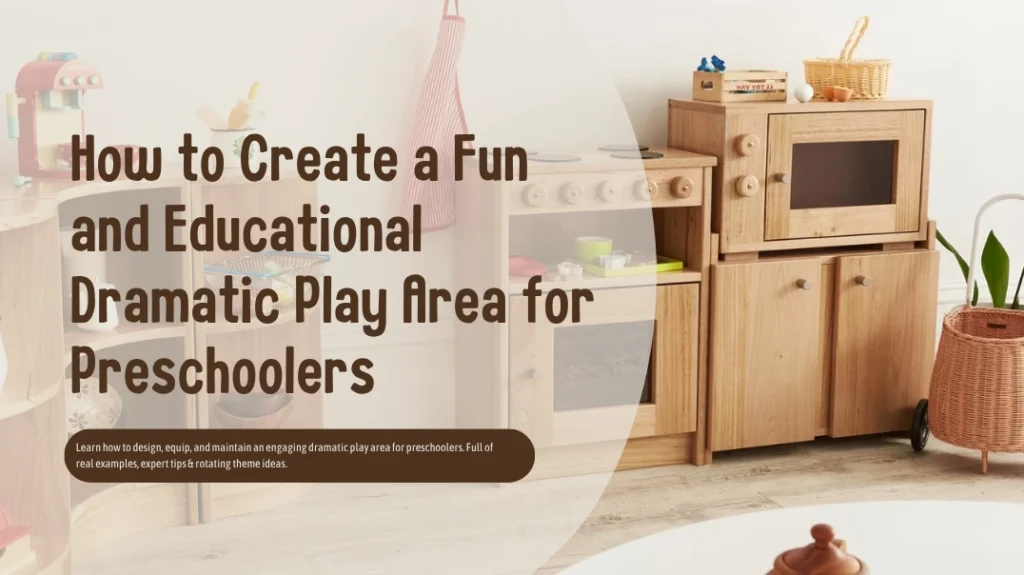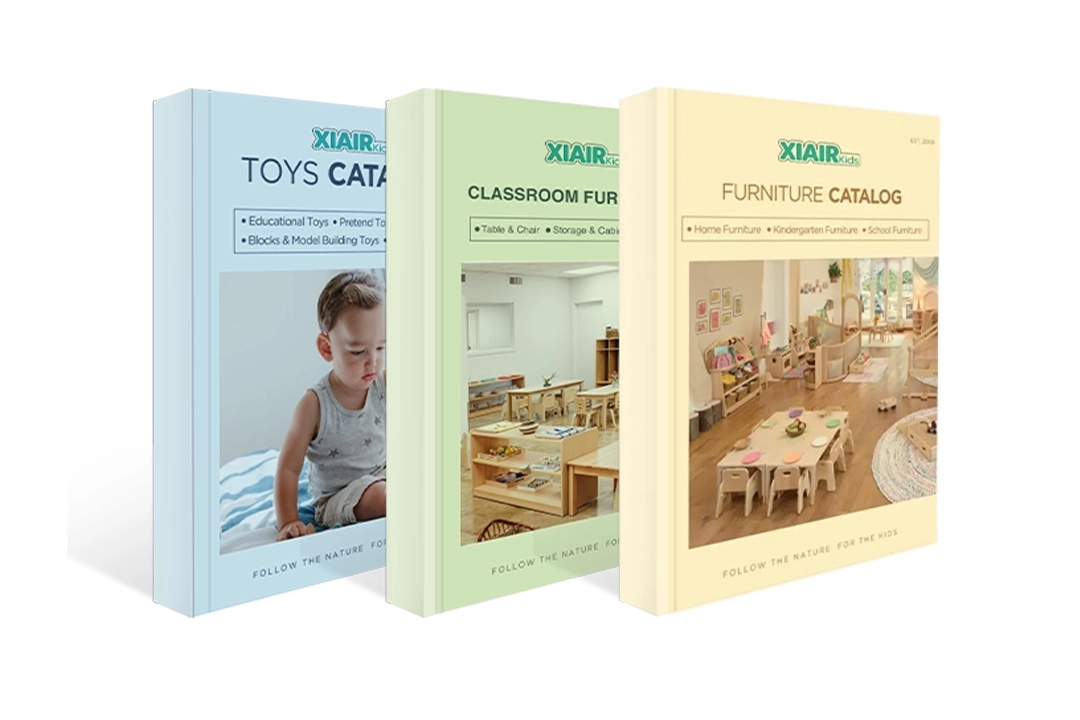Setting up a dramatic play area sounds simple—throw in a few costumes and maybe a toy kitchen, and you’re done, right? Not quite.
Many preschool dramatic play areas end up underused or chaotic, not because kids don’t want to play, but because the space wasn’t designed with intention. Without the right setup, a dramatic play area can become cluttered, repetitive, or frustrating. It misses the chance to support language, social skills, and creativity in a meaningful way.
You don’t need expensive props or a massive classroom to create a dramatic play area that works. In this guide, I’ll walk you through setting up a preschool dramatic play area that encourages imagination, supports learning, and stays organized—step by step.
Introduction
Before jumping into the setup, understanding why a well-designed dramatic play area matters so much in early learning is worthwhile. In the sections ahead, we’ll explore what a dramatic play area is, its benefits to preschoolers, and how to design one that supports creativity, learning, and engagement—without overwhelming your space or budget.
Why Every Preschool Needs a Dramatic Play Area
A dramatic play area is more than a corner with costumes or a pretend kitchen—it’s a space where preschoolers explore their world, express emotions, and build lifelong skills through play. Whether in a classroom, daycare, or home environment, creating a dramatic play area for preschoolers can make a big difference in how children learn and interact.
This section breaks down what a dramatic play area is, why it’s essential in early childhood education, and what real learning happens inside these creative spaces.
What Is a Dramatic Play Area?
A dramatic play area is a dedicated space where children take on roles, act out real-life or imaginary situations, and use props, language, and movement to create stories. It’s pretend play that mimics the world around them—like going to the grocery store, visiting the doctor, or working at a pizza shop.
Unlike free play with toys, a dramatic play center gives structure and purpose to children’s imagination. It usually includes:
- Child-sized furniture and realistic materials
- Costumes or accessories for different roles
- Defined space that sets it apart from other learning areas
- Themes that rotate throughout the year
In short, a preschool dramatic play area provides a safe, familiar environment for kids to explore social roles, daily routines, and big emotions—through play.
Benefits of Dramatic Play in Early Childhood
The impact of a well-designed dramatic play area in early childhood settings is often underestimated. While it may look like simple fun, research shows that dramatic play supports nearly every aspect of a child’s development.
Some of the key benefits include:
- Language development: Children practice new words, sentence structures, and storytelling as they interact with others in the dramatic play center.
- Social skills: They learn to share, negotiate roles, and work together within a shared space and storyline.
- Emotional regulation: Kids use pretend scenarios to express feelings, solve problems, and work through stress or fear.
- Cognitive flexibility: Switching roles and responding to new storylines boosts creativity and mental agility.
- Understanding routines and roles: Acting out daily life—like visiting a doctor’s dramatic play area or a vet center’s dramatic play—helps children make sense of the world.
This is why nearly every early childhood classroom includes some dramatic play area, whether a complete setup or a simple pretend play corner.
What Can Children Learn in a Dramatic Play Center?
Learning happens every moment in a dramatic play center—even if it looks like make-believe. Children aren’t just pretending—they’re building critical skills for school and life.
Here are just a few things preschoolers learn in a dramatic play area:
- Communication: How to express needs, ask questions, and listen to peers
- Cooperation: How to take turns, share space, and agree on story roles
- Problem-solving: How to handle unexpected changes in the game or fix pretend problems
- Empathy: What it feels like to be someone else—whether a chef, a patient, or a firefighter
- Sequencing and planning: Organizing actions into logical steps (like “first we shop, then we cook”)
When children are deeply engaged in pretend play, they’re not just playing—they’re practicing real-world skills in a space that feels safe, exciting, and totally theirs.
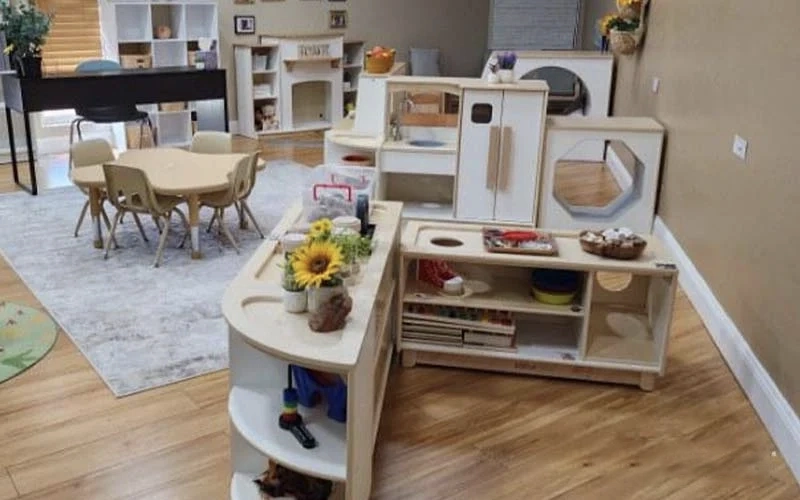
Step-by-Step Guide to Setting Up a Dramatic Play Area
Setting up a dramatic play area takes more than a few costumes and some creativity. It’s about building a space that invites exploration, supports development, and adapts over time. In this step-by-step guide, you’ll learn to choose the correct location, pick engaging pretend play themes, select child-friendly furniture, and add purposeful props. So your dramatic play center becomes a favorite place for learning through play.
Step 1: Choose the Location and Size of Your Dramatic Play Area
Before you even think about themes, furniture, or materials, the first—and arguably most important—step in setting up a successful dramatic play area is choosing the correct location and size. This decision sets the tone for everything that follows. A poorly placed play area can lead to constant interruptions, noise spillover, or disengaged children. But when thoughtfully positioned, it becomes a magnetic space that invites children into rich, sustained pretend play.
The same principles apply whether you’re working in a preschool classroom, a daycare center, or setting up a pretend play corner at home.
Find a Space That Supports Focused, Imaginative Play
The dramatic play center needs to feel special. It should signal to children, even visually, that “this is a space for stories, for characters, for transformation.” That feeling starts with physical placement.
Here’s what you want to aim for:
- A semi-enclosed corner or edge of the room. This creates a natural “stage” effect and helps define the space without requiring rigid boundaries.
- Avoid high-traffic areas. Don’t put your dramatic play setup near the entry door, circle time rug, or block center. Children need time to immerse themselves in their roles; background movement or noise can be distracting.
- Allow for supervision without hovering. Whether you’re a teacher or a parent, choose a location that allows you to observe without disrupting the flow of play. Open-sided setups work well for this.
This setup isn’t just about visibility—it’s about psychology. When a child sees a cozy, dedicated space stocked with real-world items, it becomes far more than a toy zone. It becomes their mini-world.
Think About the Natural Flow of the Room
Dramatic play areas work best when integrated with—but not lost in—the larger classroom environment. Ask yourself:
- Will children bump into this area on their way to the sink, snack table, or cubbies?
- Does it feel “tacked on,” or like a purposeful part of the learning layout?
- Can children comfortably transition in and out of play without disturbing other activities?
Here’s a tip many experienced educators follow: Place the dramatic play area near the writing or art center. Play often inspires drawing menus, writing signs, or creating storybooks, reinforcing literacy development and creating a natural partnership between centers.
Placing the pretend play area near a bookshelf or small art station at home can invite similar cross-functional play.
How Much Space Do You Need?
This is one of the most common questions—and for good reason. The answer depends on three things:
- How many children will use it at once?
Most early childhood classrooms plan for 2–4 children to use the dramatic play area at a time. You’ll want at least enough space for each child to move, access props, and stay “in character” without stepping on each other. - How elaborate are your themes?
A home living dramatic play setup (kitchen, table, dress-up) takes less room than a veterinarian clinic dramatic play center, which may involve multiple “stations” (reception, exam table, x-ray wall). - How flexible is your furniture?
You can do more with less space if your furniture can be easily moved or reconfigured. For example, a table used for a restaurant dramatic play one week can become a patient bed or checkout counter the next.
| Type of Setup | Ideal Space Needed | Example Themes |
|---|---|---|
| Small Corner | 4’ x 5’ | Kitchen, home, reading nook |
| Medium Setup | 6’ x 8’ | Post office, grocery store, classroom |
| Large Interactive Space | 8’ x 10’ or more | Fire station, hospital, construction site |
In a home setting, even a 3’ x 4’ area near a wall can become a dynamic, dramatic play space if you use vertical storage and rotating props.
Consider How the Area Will Grow Over Time
One mistake many teachers make is setting up a dramatic play center once and leaving it untouched. However, children’s interests evolve, and a well-designed dramatic play area should adapt, not stay frozen.
When choosing your location and size, think long-term:
- Can you add seasonal decorations or background posters?
- Is there space to swap out large items (e.g., a kitchen for a market stall)?
- Are there wall surfaces nearby for adding signs, pretend menus, or charts?
Design the footprint for flexibility without requiring a total room rearrangement every month.
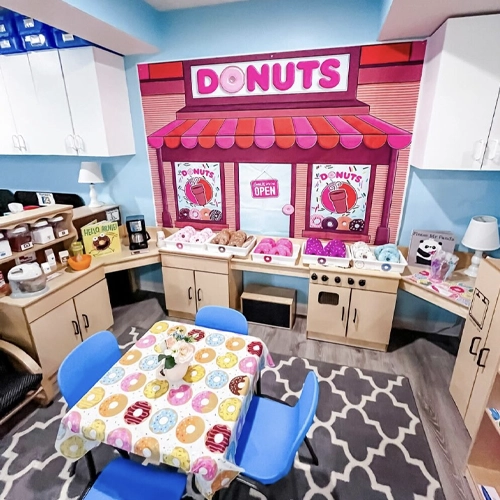
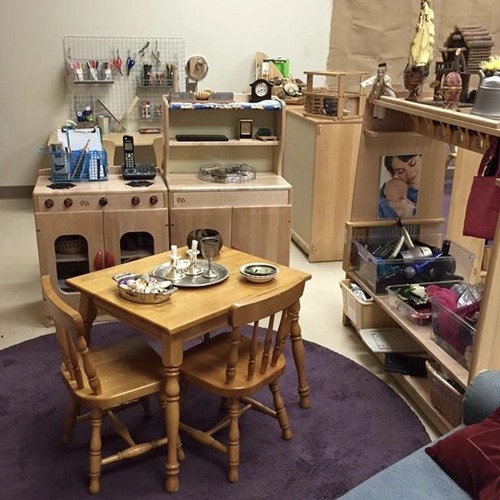
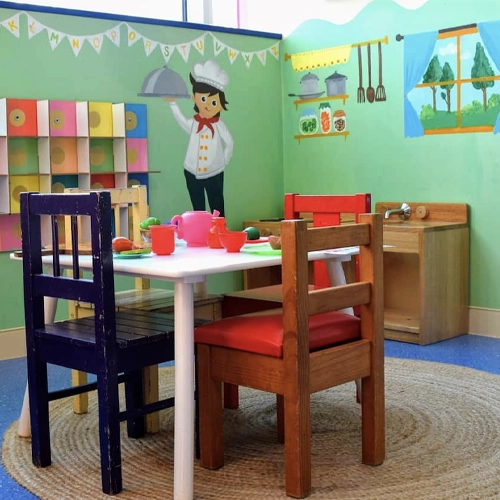
Step 2: Select the Right Dramatic Play Themes
Once you’ve set up the space for your dramatic play area, it’s time to decide what will happen inside it—and that starts with choosing the right themes.
Themes bring structure, variety, and purpose to pretend play. They help children connect with familiar roles, discover new ones, and explore real-world concepts through imagination. In a well-planned dramatic play center, themes aren’t just decorations—they’re the heart of the experience.
Why Themes Matter in a Dramatic Play Area
A dramatic play area without a theme is like a stage without a script. Children will play, but their engagement may be shallow or short-lived. Themes:
- Give context to the play
- Encourage new vocabulary and social interaction
- Allow educators to support specific learning goals
- Keep the space feeling fresh, even if the structure stays the same
Rotating themes allows you to revisit key concepts—community roles, storytelling, seasonal changes—while keeping children curious and inspired.
How to Choose the Right Theme
There’s no one-size-fits-all formula, but you can base your theme choices on:
- Children’s current interests
(Are they pretending to be firefighters? Obsessed with animals?) - Your classroom or homeschool learning goals
(Teaching about health? Try a doctor’s office. Learning about letters? Set up a post office.) - Season or holidays
(Pumpkin patch in fall, Santa’s workshop in December, flower shop in spring.) - Available space and materials
(A kitchen or café works well in tight spaces; a zoo or hospital needs more room.)
Ensure the theme is open-ended enough for different types of play: solitary, parallel, and cooperative.
Theme Ideas for Your Dramatic Play Area
Choosing the right theme is the heart of a powerful, dramatic play area. Below are five versatile theme categories that combine structure with flexibility. Each group reflects real-life learning and supports different areas of child development. These are ideal for preschool classrooms, daycare settings, and home pretend play corners.
1. Community Helpers & Real-Life Roles
These themes allow children to explore adult responsibilities, practice empathy, and understand how communities work. They also tie beautifully into social studies units and early citizenship lessons.
- Doctor’s Office Dramatic Play Area
- Fire Station Dramatic Play Center
- Vet Clinic Dramatic Play Area
- Post Office Dramatic Play Center
- Dentist Office
- Police Station Dramatic Play Area
- Hospital Dramatic Play Center
- Recycling Center Dramatic Play Setup
- Construction Site Dramatic Play Area
- School / Classroom Dramatic Play Center
Great for social-emotional development, role-playing scenarios, and language-rich conversations.
2. Everyday Places & Routines
Familiar daily settings help children connect pretend play to real life. These dramatic play area ideas mimic environments children see regularly—encouraging storytelling, independence, and basic math/literacy skills.
- Grocery Store Dramatic Play Area
- Bakery Dramatic Play Center
- Pizza Shop Dramatic Play Center
- Flower Shop Dramatic Play Setup
- Kitchen or Home Living Dramatic Play Area
- Beauty Salon
- Library Dramatic Play Center
- Farmers Market Dramatic Play Area
- Restaurant or Cafe Setup
- Coffee Shop Dramatic Play Center
Ideal for boosting sequencing skills, functional language, and community awareness.
3. Seasonal & Holiday Themes
These time-sensitive themes keep your dramatic play area feeling fresh while introducing children to culture, tradition, and seasonal changes. They also offer rich vocabulary and literacy opportunities tied to the calendar.
- Pumpkin Patch Dramatic Play Center
- Winter Wonderland Dramatic Play Area
- Santa’s Workshop
- Valentine’s Day Flower Shop
- Thanksgiving Dinner Setup
- Spring Market
- Easter Egg Decorating
- Halloween Costume Shop
- Hot Cocoa Stand
- Back-to-School Classroom Setup
Best for timely rotation (monthly or seasonal), sensory-rich props, and festive exploration.
4. Science, Nature & Exploration Themes
Encourage wonder and inquiry through themes that invite children to imagine, discover, and investigate. These dramatic play areas perfectly integrate STEM learning and support child-led discovery.
- Space Station Dramatic Play Area
- Zoo Dramatic Play Center
- Aquarium Pretend Play Setup
- Dinosaur Dig Site
- Camping Dramatic Play Area
- Pet Store Dramatic Play Center
- Garden Center Dramatic Play
- Arctic Research Lab
- Airport Dramatic Play Center
- Transportation & Travel Theme
Excellent for building expressive language, scientific thinking, and storytelling.
5. Reggio-Inspired or Child-Led Themes
Rather than preset themes, this approach invites children to co-create the play environment based on curiosity. It encourages deep involvement, emergent learning, and flexible thinking.
- Ice Cream Shop (after pretend snack time)
- My Neighborhood (based on children’s stories)
- Superheroes & Helpers
- Family Center / Baby Care
- Pet Hospital (inspired by favorite toys)
- Fitness Center
- Home Depot / Tool Workshop
- Target Store Dramatic Play Center
Recommended for child-led environments or project-based learning settings.
This list isn’t exhaustive, but gives you a solid base to build. For an expanded version, you can direct readers to your internal article on dramatic play ideas with dozens more creative suggestions.
How Often Should You Change Themes?
A good rhythm is every 2 to 4 weeks, depending on:
- Child interest level
- Classroom schedule
- Complexity of setup
You don’t need to start from scratch each time. Many themes reuse the same base furniture and swap out signs, props, and context. (We’ll talk more about props and layout in the following steps.)
Include Children in the Process
Some of the best dramatic play themes come directly from the children themselves. If they’re building towers and pretending they’re trucks, maybe it’s time for a construction dramatic play center. A vet clinic or animal shelter could be perfect if they care for their stuffed animals.
Let them help pick the next theme, or set it up with you. Ownership equals investment—and better play.
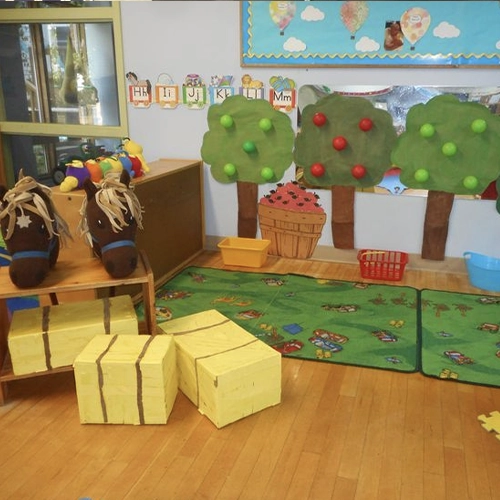
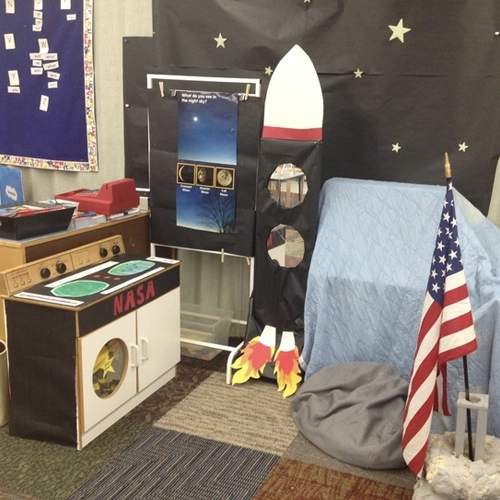
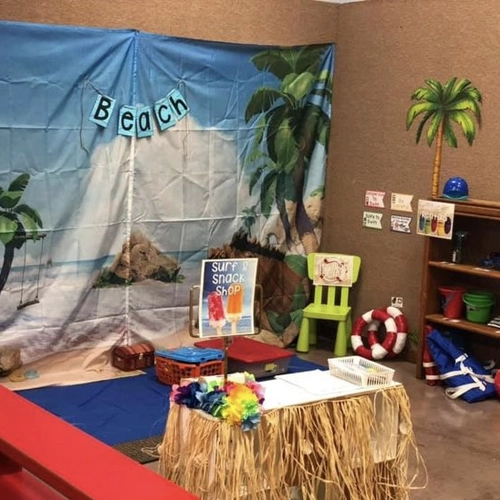
Step 3: Choose the Right Furniture & Equipment for Your Dramatic Play Area
Every well-designed dramatic play area needs more than just creativity—it needs the right equipment to bring that creativity to life. While props and costumes add flair, the dramatic play furniture anchors the theme, sets boundaries, and invites immersive role play.
Unlike general classroom furniture, dramatic play furniture is intentionally themed and scaled for children. Depending on your setup, it transforms a simple corner into a working kitchen, a bustling market, or a cozy nursery.
Why It Matters
- Structure: Clearly defines the space and separates themes
- Functionality: Supports pretend scenarios that mimic real-life roles
- Safety: Purpose-built for young children—stable, rounded, and durable
- Flexibility: Easily supports rotation of themes throughout the year
Let’s look closely at the main categories of pretend play furniture and the typical items each includes.
Dramatic Play Furniture by Category
Here’s a practical breakdown of dramatic play furniture types, plus specific product examples to help you set up your center with confidence:
1. Play Kitchen Sets
A staple in nearly every dramatic play area, play kitchens help children explore routines, caregiving, and cooking familiarly and engagingly.
- Wooden Play Stove
- Pretend Sink with Knobs
- Play Refrigerator
- Microwave Unit
- Kitchen Island
- Pantry or Storage Cupboard
- Toy Dishwasher
Perfect For Themes Like:
Home living, restaurant, bakery, breakfast café
2. Market Stalls & Store Counters
These help children take on roles like cashier, vendor, or customer. They are perfect for practicing social interaction and early math skills.
- Grocery Checkout Counter
- Market Stand with Awning
- Pretend Bakery Display Shelf
- Ice Cream Cart
- Toy Register Table
- Produce Crate Display
- Flower Shop Counter
- Shopping Basket Stand
Perfect For Themes Like:
Grocery store, flower shop, farmers market, café, post office
3. Dress-Up Units with Mirrors
This category is essential for supporting identity exploration and social play. Children seeing themselves in costume deepens the realism and commitment to role-playing.
- Child-Sized Dress-Up Wardrobe
- Full-Length Mirror (child-safe)
- Costume Rack with Storage Bins
- Vanity Station with Mirror
- Hanging Rods for Uniforms
- Accessory Cubbies
Perfect For Themes Like:
Beauty salon, construction zone, police/fire station, fantasy characters
4. Puppet Theaters & Mini Stages
Puppetry and storytelling allow children to build language and imagination while performing solo or in groups.
- Floor Puppet Theater Frame
- Tabletop Puppet Stage
- Portable Curtain Theater
- Drama Stage Panels
- Puppet Storage Box
- Storytelling Bench
Perfect For Themes Like:
Library, fairy tales, animal rescue, holiday celebrations
5. Housekeeping & Baby Care Units
These furniture pieces encourage nurturing play and empathy. Great for themes that involve caregiving or household responsibilities.
- Pretend Washing Machine
- Doll Changing Table
- Toy Ironing Board
- Baby Crib or Bassinet
- Doll High Chair
- Housekeeping Combo Unit
Perfect For Themes Like:
Family home, daycare center, pediatric clinic
6. Modular & Open-Ended Furniture Pieces
Modular items can be reimagined for any setting, offering unlimited flexibility. They are invaluable in classrooms that frequently rotate themes or follow a Reggio Emilia approach.
- Wooden Cubes
- Bench Seating with Storage
- Convertible Counters
- Frame Panels with Windows
- Arched Doorway Panels
- Mobile Rolling Stations
Perfect For Themes Like:
Any child-led or seasonal theme, open-ended exploration
Looking to build your dramatic play area with versatile, high-quality equipment? Explore our Pretend Play Furniture Collection to find durable kitchen sets, modular counters, dress-up centers, and more—designed with real classrooms and home learning spaces in mind.
Designing for Function, Safety, and Flexibility
Whether in a preschool classroom or home learning corner, all dramatic play furniture should be:
- Child-height and independently accessible
- Rounded edges, stable design, child-safe finishes
- Durable and easy to clean
- Modular enough to support multiple themes
- Visually appealing but not overly specific (neutral colors = more reuse)
- Can this furniture support more than one theme?
- You only need 1–2 oversized items per theme to make it effective.
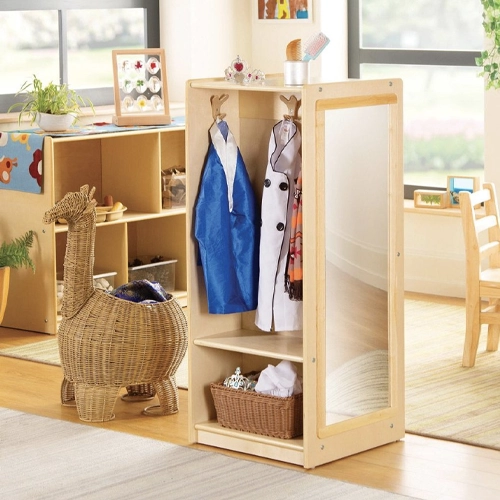
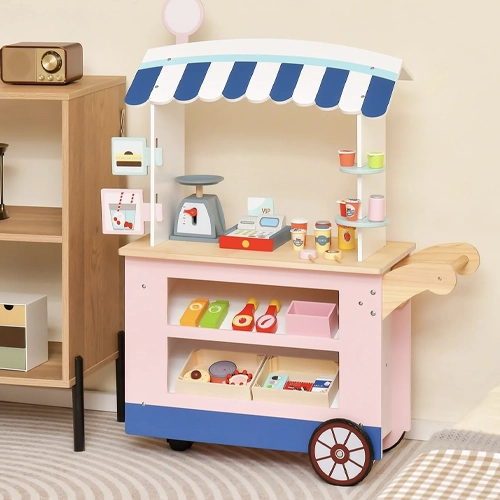
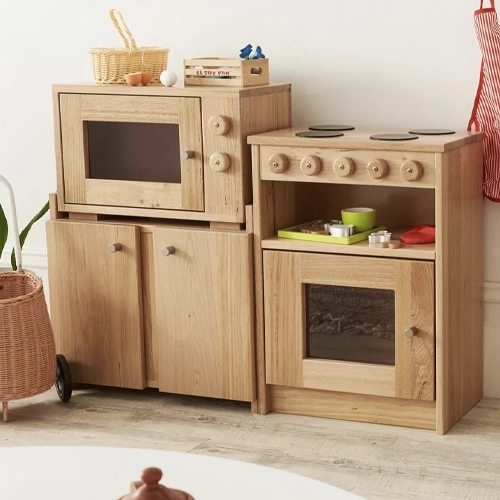
Step 4: Select Props and Materials for Your Dramatic Play Area
After setting up the furniture, the following essential step is choosing props and materials that spark imagination and invite rich, meaningful play. The right props encourage storytelling, collaboration, and development—far beyond mere decoration.
1. Common Props and Materials for Dramatic Play
Whether setting up a home kitchen, vet clinic, grocery store, or post office, having the right props on hand is key to immersive pretend play. Below is a list of highly recommended, classroom-tested materials you can include in your dramatic play area.
Home Living & Kitchen Themes
- Plastic or wooden fruits and vegetables
- Toy pots, pans, bowls, and utensils
- Play toaster, microwave, or coffee machine
- Pretend spice jars, cartons, and condiment bottles
- Cloth napkins, placemats, oven mitts
- Play with dishes, cups, and cutlery
- Empty food boxes (e.g., cereal, pasta, milk cartons)
- Menus and order pads
Doctor’s Office or Hospital
- Stethoscopes, thermometers, syringes (toy)
- Bandages, cotton balls, medicine bottles (empty)
- Clipboards and patient charts
- Hospital gowns or lab coats
- Toy phone for emergency calls
- Pretend eye chart
- Patient name tags, appointment cards
Post Office or Delivery Center
- Envelopes, notepads, stamps (stickers)
- Mailbags or small shoulder bags
- Play weighing scale
- Toy computer or keyboard
- Boxes and packaging tape (safe for kids)
- Address labels and sticky notes
- Postcards and printed pretend letters
Grocery Store or Market
- Mini shopping carts or baskets
- Play money, coins, credit cards
- Toy barcode scanner
- Empty product boxes (repackaged neatly)
- Scales and price tags
- Store signs: “Open”, “Sale”, “Checkout”
- Paper bags or small fabric totes
- Receipt pad
Veterinarian Clinic
- Animal figurines or stuffed animals
- Pet carriers and collars
- Thermometers and bandage rolls
- “X-ray” sheets (drawn or printed on transparency paper)
- Pretend food and water bowls
- Brush, comb, and grooming tools
- Adoption forms and ID cards
Baby Care & Nursery
- Dolls (diverse in gender, ethnicity)
- Doll clothes, diapers, bottles
- Blankets and toy pacifiers
- Changing pads or pretend wipes
- Baby food jars (empty or mock)
- Toy stroller or crib
- Burp cloth, bibs, small laundry basket
Beauty Salon or Dress-Up Corner
- Comb, brush, hair clips
- Scarves, hats, glasses, costume jewelry
- Capes or aprons
- Toy blow dryer or pretend makeup sets
- Mirror and small vanity table
- Customer appointment card
- Fashion magazine pages (laminated)
Imaginative Themes (Fairy Tale, Space, etc.)
- Walkie-talkies or space communicators
- Crowns, capes, wands
- Cardboard shields or helmets
- Play with a telescope or binoculars
- Alien or astronaut costumes
- Treasure maps, magic stones, scrolls
2. Suggested Dramatic Play Kits and DIY Inspiration
Want to make setting up easier or more customizable? Consider these ideas:
- Theme-Based Kits (pre-packaged or DIY): kitchen cooking sets, doctor’s kits, postal role-play bags
- Color-Coded Sets: use matching containers for each theme—for example, red bins for bakery items, green bins for garden play
- DIY Ideas: upcycle old phone devices, turn repurposed boxes into mailboxes or shopping carts
These pre-planned or custom kits streamline setup and enrich storytelling in your dramatic play center.
3. Note: Printable Resources and Labels
While printable props (like labels or signage) aren’t central to this step, they can enhance your dramatic play area when used thoughtfully. Examples include:
- Role badges (Chef, Doctor, Cashier)
- Simple “Open/Closed” signs
- Price tags, menus, or schedule boards
Remember, the focus remains on physical materials—printables are supportive but not essential.
4. How to Organize and Store Your Props Efficiently
An organized dramatic play area keeps the space inviting and manageable. Try these strategies:
- Label Containers by Theme: e.g., “Post Office Props,” “Bakery Tools”
- Rotate Themes: store off-season items neatly and cycle them monthly or seasonally.
- Involve Children in Cleanup: Label bins with words or pictures for easy sorting.
- Use Visual Cues: small images instead of words help younger children identify where items go.
Well-managed materials support both independent play and engaged learning.
Your perfect classroom is one click away!
Tips for Maintaining and Rotating Your Dramatic Play Area
Maintaining a dramatic play area doesn’t have to be overwhelming. With a few innovative strategies, you can keep the space organized, relevant, and fresh—without burning yourself out.
Rotating props and themes periodically also helps children stay engaged, while giving you the chance to reinforce new vocabulary, seasonal events, or curriculum goals.
How Often Should You Rotate Themes?
There’s no one-size-fits-all rule, but most early childhood classrooms benefit from rotating dramatic play themes every 2 to 4 weeks. Some teachers rotate monthly to align with holidays or seasons, while others rotate based on children’s current interests or observed boredom with the current theme.
- Plan a theme calendar to reduce decision-making stress
- Use natural events (e.g., Halloween, Chinese New Year) as anchor points
- Keep a few universal props (like food or dolls) always accessible to bridge transitions
- Let children help choose or vote on the following theme to increase ownership and excitement
Rotating themes maintains novelty and enables you to recycle your dramatic play area for maximum impact.
Organizing Tips for Easy Cleanup and Independence
Clutter kills creativity. A clean, clearly labeled dramatic play center helps children focus on play rather than chaos—and makes your job easier.
- Use clear bins or open baskets to categorize props by theme
- Label everything with images and words so even non-readers can clean up independently
- Store off-theme materials in sealed containers away from view
- Keep your most-used dramatic play furniture pieces in place, and swap out only the accessories
- Consider a “theme shelf” that visually displays the current play focus
The more organized the space, the more confident and independent your little learners will become.
Involving Children in Setup and Cleanup
Children are more likely to take care of their environment when they’re involved in maintaining it. Make setting up and cleaning part of the learning process.
- Assign “prop helpers” or “cleanup buddies”
- Use a timer to make cleanup a game
- Let kids place labels on bins or help “design” the new setup
- Ask children to help dismantle old themes—this builds respect for the space
- Use reflection time to talk about what they liked and what they’d like next
When children feel like co-owners of the dramatic play area, they engage more deeply and treat it with care.
What’s the Difference Between Dramatic Play and Role Play?
Many people use dramatic and role play interchangeably—but they’re different. While they overlap in concept and often happen together in a preschool setting, understanding the subtle differences can help you better plan, observe, and support children’s play.
Dramatic Play: Child-Led, Open-Ended Imagination
Dramatic play is pretend play where children take on roles, act out situations, and explore different experiences using props, environments, and language. It’s usually:
- Unscripted
- Spontaneous
- Driven by the child’s ideas
For example, a child pretending to cook dinner with play food, setting the table, and inviting a “guest” engages in dramatic play. There’s no defined outcome—they’re simply exploring real-world roles and routines through imagination.
Dramatic play often happens naturally when children are given a rich environment, like a well-stocked dramatic play area with props and thematic furniture.
Role Play: Intentional Character or Job-Based Play
Role play is a more focused type of dramatic play in which a child assumes a specific identity—e.g., a firefighter, a doctor, a chef, or a post office worker—and behaves as that person.
It often involves:
- Assigned or chosen roles
- Specific goals or scenarios
- Language and behavior patterns from the role
For example, when children wear costumes and pretend to rescue people, take someone’s temperature, or deliver packages with specific dialogue, they are role-playing.
| Aspect | Dramatic Play | Role Play |
|---|---|---|
| Focus | General imagination | Specific identity or profession |
| Structure | Unstructured, child-directed | Can be structured or goal-oriented |
| Example | Pretending to go shopping or host a party | Pretending to be a cashier or vet |
| Environment Driven | Yes (props, themes) | Yes, often enhanced with costumes and setup |
| Common in | Preschool and home settings | Preschool, theater activities, SEL exercises |
Why the Distinction Matters
Understanding this difference helps you:
- Provide more intentional props and setups
- Encourage both free exploration and structured social-emotional learning
- Communicate with families and staff using consistent vocabulary
- Support a broader range of developmental goals
Most importantly, knowing how dramatic play and role play relate empowers you to build a richer, more flexible dramatic play area—where children feel safe to imagine, experiment, and grow.
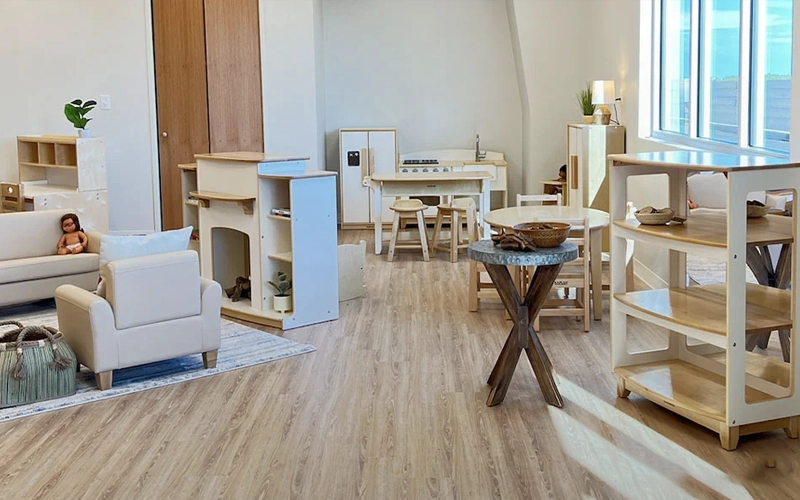
Conclusion
Setting up a meaningful dramatic play area isn’t just about furniture and props—it’s about creating a space where young minds can explore, make, and connect. Whether planning a preschool dramatic play center, designing a themed pretend play kitchen, or organizing seasonal dramatic play setups, every thoughtful detail you include becomes a tool for learning through play.
From selecting the right dramatic play furniture to rotating fresh dramatic play themes, you’re building a play corner and cultivating imagination, cooperation, language, and real-world understanding.
Don’t be afraid to experiment. Mix popular setups like a grocery store, dramatic play center, or a vet clinic, with a dramatic play station with more open-ended or culturally relevant ideas. Consider how your choices of props, dress-up items, and pretend play materials support both fun and growth.
Most importantly, involve the children. Let them help choose themes, organize props, and transform the space into something they feel proud of. A well-designed dramatic play area for preschoolers becomes more than just a corner of the classroom—it becomes a stage where real development unfolds daily.
FAQs
1. What low-cost ways to set up a dramatic play center?
You can repurpose cardboard boxes, real containers, and simple fabrics. Even reused food packaging makes great pretend play materials. Community Playthings suggests using everyday props as flexible tools for “supporting open-ended, child-directed learning.”
2. How do I introduce a new dramatic play theme to young children?
Start with a story, role model a simple scenario, or ask open-ended questions to spark curiosity. According to PBS, “Dramatic play allows kids to step into others’ shoes,” so engaging their imagination early helps them connect emotionally with the new theme.
3. Can dramatic play be linked to literacy or numeracy goals?
Yes—and it’s highly effective. Rasmussen University emphasizes that dramatic play supports early literacy by helping kids “contextualize words and concepts” through meaningful scenarios like reading menus or writing appointment slips.
4. Is it okay to mix dramatic play with sensory play elements?
Definitely. Textures, sounds, and smells enrich the experience. Verywell Family highlights that such imaginative games help children “sharpen their verbal skills” and become more engaged learners.
5. What makes a dramatic play theme developmentally appropriate?
Themes are most effective when they’re relatable and allow for varied roles. Community Playthings notes that good dramatic play themes support “cognitive and physical development,” primarily when children can act out real-life routines in playful ways.
6. How much space do I need for a dramatic play area in a small classroom?
Even a corner works well if it’s organized. IKEA, an educator favorite, often features compact pretend play furniture designed for small spaces with considerable learning potential.
7. What open-ended questions can I ask during dramatic play?
Use prompts like:
– “What job are you doing now?”
– “What happens next?”
– “Who else needs help?”
These questions extend play, build vocabulary, and develop thinking skills, as suggested by Verywell Family.
8. How do I make the dramatic play area inclusive for all children?
Offer diverse dolls, props in multiple languages, and gender-neutral roles. PBS reminds educators that dramatic play teaches empathy—making inclusivity ethical and developmentally important.
9. Is a mud kitchen considered a dramatic play area?
Yes—mud kitchens are an excellent outdoor extension of a dramatic play area. Children engage in pretend cooking, gardening, and serving, which involve role play, social interaction, and open-ended storytelling. A well-designed mud kitchen encourages creativity and sensory exploration while supporting the same developmental benefits as indoor dramatic play setups.
Want ideas for building your own? Check out our complete guide to setting up a mud kitchen for preschoolers.

